Introducing QualBot Copilot Mode
We are excited to introduce Copilot Mode, a structured, step-by-step workflow within QualBot that brings the rigor of gold-standard thematic analysis into an intuitive and AI-powered environment.
Rooted in the widely adopted framework of Braun and Clarke (2006) or Naeem et al. (2023), Copilot Mode was designed to guide researchers through every critical phase of thematic analysis—without shortcuts, and without compromising depth, nuance, or accuracy.
Whether you're an experienced qualitative researcher or just getting started, Copilot Mode supports a process that's transparent, grounded in the data, and 100% hallucination-free.
Why Methodology Matters
As qualitative researchers, we know that meaningful analysis doesn't come from just "summarizing" text. It involves a careful, multi-step process of familiarizing yourself with the data, coding, theme development, refinement, and grounding in evidence. Copilot Mode aligns with this structure, using AI to support—but not replace—the researcher's judgment.
At every step, you remain in control. QualBot simply removes the friction: no need for sticky notes, color-coded spreadsheets, or endless back-and-forth between documents. endless back-and-forth between documents.
Step-by-Step: Thematic Analysis, Copilot Style
🧠 Step 1: Familiarize Yourself with the Data
Just as Braun and Clarke emphasize immersion in the dataset, Copilot begins by helping you get close to your data. In the "Explore Docs" tab, you can chat directly with transcripts—asking questions, highlighting contradictions, and surfacing patterns. Use this feature to explore the data or to check for specific topics and themes.
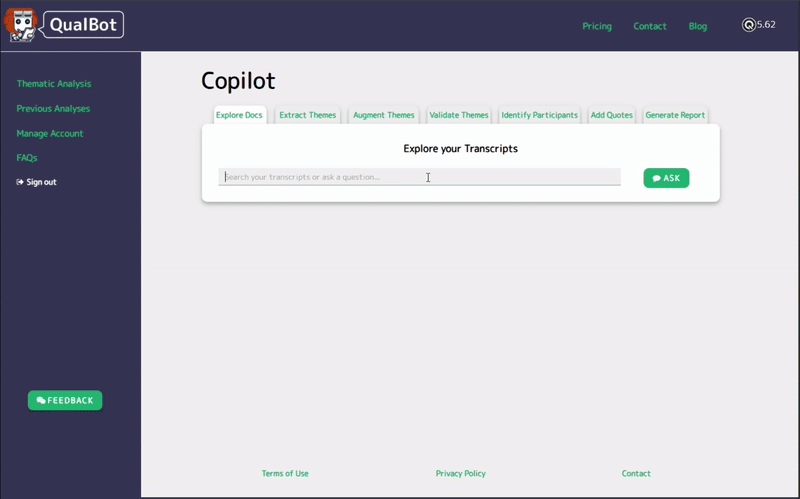
🏷️ Step 2: Identify Initial Themes
Now that you're grounded in the data, it's time to identify initial codes and candidate themes. You can either provide your own topic structure or prompt the AI to generate a hierarchical set of high-level topics and subtopics.
QualBot implements an automated data coding and inductive theme extraction process that mirrors the flexible, iterative coding process Braun and Clarke advocate—structured, yet flexible.
QualBot will organize the themes with one topic per tab. You can filter for specific subtopics or keywords and add, edit, or delete themes at any time. You can also download them locally in csv format.
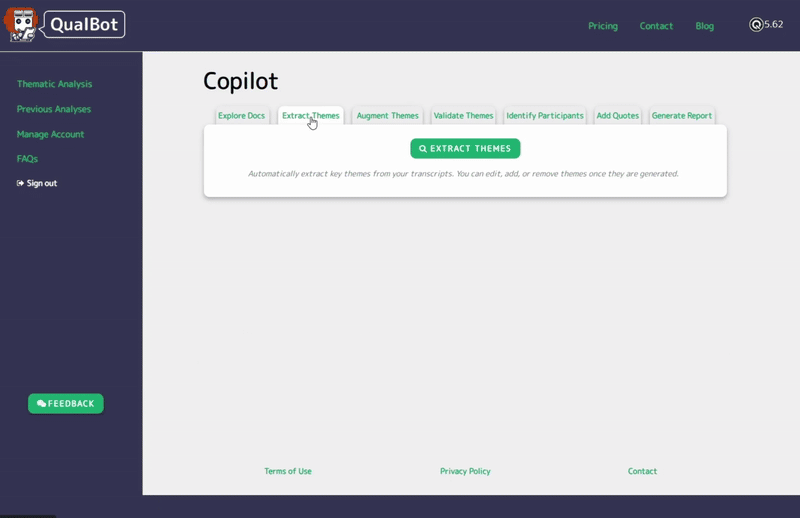
🔍 Step 3: Augment Themes
The "Augment Themes" tab supports theme refinement. Here, you can direct QualBot to focus on specific aspects of the data, helping you unpack deeper subthemes, contradictions, or variations. This is especially valuable for researchers seeking rich thematic descriptions across diverse participant voices or contexts.
One key difference with the "Extract Themes" tab is that you can prompt QualBot to augment themes in specific ways, either by providing analytic guidelines (e.g. "focus on differences in respondent opinion by gender"), stylistic preferences (e.g. "use an academic tone") or to focus on specific aspects of the data (e.g. "focus on management implications").
As in the previous tab, QualBot will organize the themes with one topic per tab and yyu can filter, add, edit, or delete themes at any time. You can also download them locally in csv format.
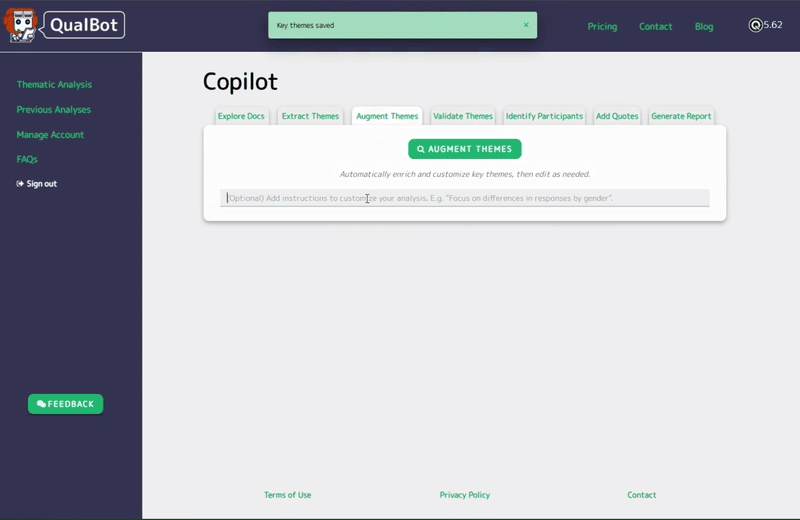
🔎 Step 4: Validate Themes Against the Data
This is where Copilot Mode truly shines—helping ensure your analysis is both grounded and defensible. In the "Validate Themes" tab, you can fine-tune the rigor of your thematic analysis by setting how closely a paragraph must align with a given theme, and by defining the minimum threshold of supporting evidence required. This ensures that every theme is backed by meaningful, representative data. IMPORTANT: Themes lacking sufficient evidence will be removed from subsequent steps.
At the core of this process is the codebook—a structured summary of all identified themes, showing the number of documents and specific paragraphs linked to each theme, along with their average sentiment score, ranging from -1 (Negative) to 1 (Positive). The codebook acts as your analytical anchor, making the logic behind your themes transparent, traceable, and easy to communicate to peers, clients, or stakeholders.
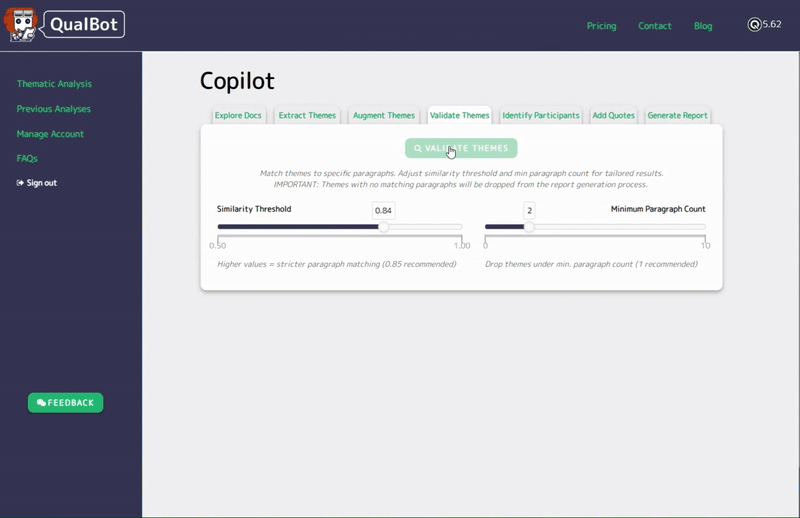
Complementing the codebook is the sunburst graph, an interactive visual that brings your analysis to life. It displays the hierarchical relationship between topics, subtopics, and themes, along with their relative frequency in the dataset, the supporting text, and associated sentiment. This makes it easy to spot dominant patterns, thematic overlaps, and gaps in coverage—offering both a high-level snapshot and a deeper, paragraph-level view of your qualitative data.

👥 Step 5: Confirm and Describe Participants
Participant context is often underdeveloped in AI-generated analysis, reducing the richness and nuance that qualitative research depends on. Copilot Mode addresses this by automatically detecting and describing participants—grouped by interview—based on cues from the transcript itself. These descriptions highlight distinguishing characteristics and help bring individual voices into sharper focus.
You can go beyond automation by adding, editing, or removing participants as needed. You can also regenerate participant avatars to visually reflect updated attributes, helping to humanize and contextualize your findings in a way that's both flexible and deeply grounded in the data.
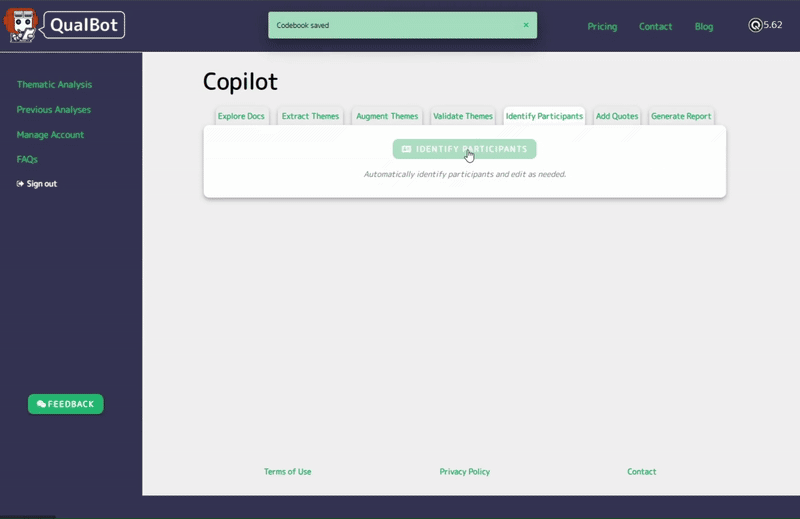
🗣️ Step 6: Select Verbatim Quotes
Illustrating themes with quotes is a hallmark of high-quality qualitative reporting—it brings your analysis to life and allows readers to hear directly from participants in their own words. In this step, QualBot surfaces relevant and representative quotes for each theme, allowing you to select those that are most compelling and illustrative. This ensures that your final report reflects not only the structure of your analysis, but also the richness and diversity of participant voices.
To maintain analytical integrity, verbatim editing is not permitted. Quotes are pulled directly from the source transcripts, and QualBot applies strict verbatim verification to ensure accuracy and prevent any hallucinations or fabrications. This rigorous approach safeguards the trustworthiness of your analysis and supports evidence-based storytelling grounded in authentic participant narratives.
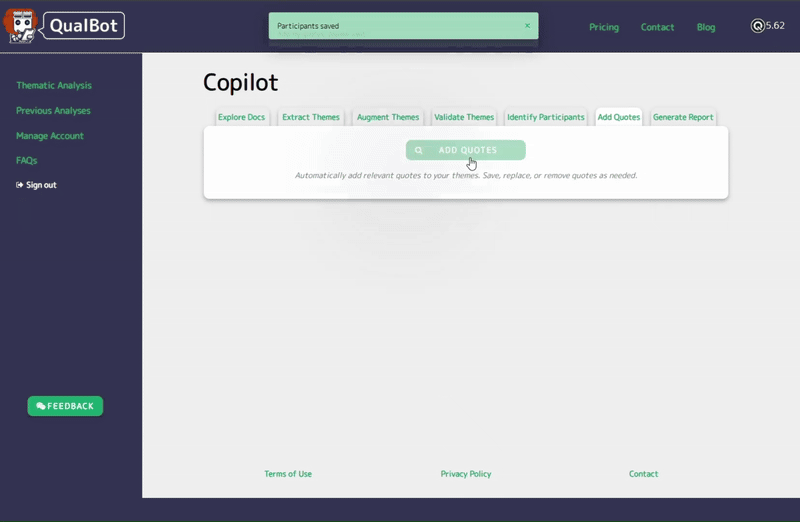
📄 Step 7: Generate the Report
After completing all steps, you can generate your full report—organized by themes and supported by evidence. You can view it in the QualBot console, open it in Google Docs, or download it for local editing. Because each component is backed by transparent data, the final output is auditable, grounded, and reproducible.
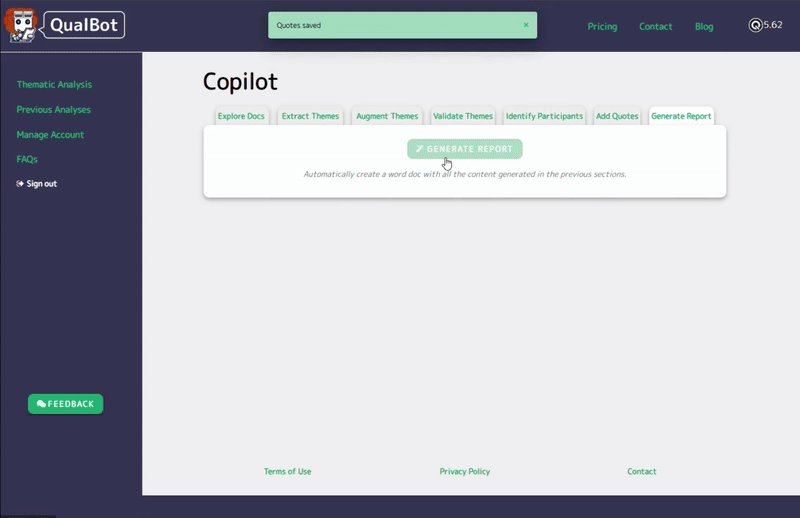
Built for Rigor. Designed for Real-World Use.
Copilot Mode is developed to support and enhance thematic analysis workflows, particularly those inspired by Braun & Clarke's flexible, iterative approach. Key features are designed to:
- Align with established qualitative research methods.
- Ensure that all themes are grounded in the source data—never generated without evidence.
- Produce outputs that are comprehensive, transparent, and easy to audit.
- Allow researchers to stay in control while minimizing repetitive manual work.
Whether you're working in academic research, program evaluation, or applied market research, Copilot Mode provides a structured yet adaptable environment for producing thoughtful, well-supported qualitative findings.
Try It. Test It. Tell Us What You Think.
We're proud of Copilot Mode, but we know it will get even better with your feedback. Try it out, and let us know what's working—and what could be improved.
Qualitative research deserves tools that match its complexity. We think Copilot Mode is a big step in that direction.
References
- Braun, V., & Clarke, V. (2006). Using thematic analysis in psychology. Qualitative Research in Psychology, 3(2), 77–101.
- Naeem, M., Ozuem, W., Howell, K., & Ranfagni, S. (2023). A step-by-step process of thematic analysis to develop a conceptual model in qualitative research. International Journal of Qualitative Methods, 22, 16094069231205789.